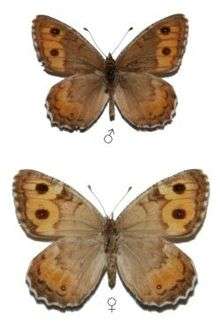Pseudochazara hippolyte
Pseudochazara hippolyte is a species of butterfly in the family Nymphalidae.[1] It is confined from the southern Urals across Kazakhstan and northern Tian-Shan to Transbaikalia, Mongolia and northern Tibet.
- A similar species, formerly regarded as a subspecies of Pseudochazara hippolyte, but endemic from south of Spain, is Pseudochazara williamsi.
| Pseudochazara hippolyte | |
|---|---|
 | |
| Scientific classification | |
| Kingdom: | |
| Phylum: | |
| Class: | |
| Order: | |
| Family: | |
| Genus: | |
| Species: | P. hippolyte |
| Binomial name | |
| Pseudochazara hippolyte (Esper, [1784]) | |
| Synonyms | |
| |
Description in Seitz
S. hippolyte Esp. (= alcyone F., agave Esp.) (43 b). Similar to the preceding [ S. autonoe ] in size and shape, but the distal band is on both wings broad, sharply defined and yellowish, being distally tinged with yellowish red. In the nymotypical form the hindwing beneath bears 3 distinct dentate lines, the ground-colour being often so darkened between the first two that there appears a dark median band. In Spain and South Russia as well as in Anterior Asia. — The form mercurius Stgr., from the Tian-shan district, has the bands brighter yellow, and in rhena H.-Schiff , from Tokat, they have a strong orange tint. — On the other hand, Elwes found in the higher Altai a smaller form in which the bands are pure pale yellow, not being tinged with orange, but being traversed by the heavy dark veins; this is pallida Stgr. (43b), which is distinguished, moreover, by the underside of the hindwing being minutely but evenly irrorated with dust-grey. — hippolyte is common in June and July at its flight-places, steppes and sterile meadow; it settles on naked places on the ground and flies only a short distance when disturbed, therefore being easy to catch (Elwes).[2]
Flight period
The species is univoltine and is on wing from July to August.
Food plants
Larvae feed on grasses.
Subspecies
- Pseudochazara hippolyte hippolyte
- Pseudochazara hippolyte doerriesi southern Siberia (Tuva region)
- Pseudochazara hippolyte mercurius (Staudinger, 1887) northern Tian Shan, Dzhungarsky Alatau, Saur and Tarbagatai
References
- "Pseudochazara de Lesse, 1951" at Markku Savela's Lepidoptera and Some Other Life Forms
- Seitz in Seitz, A. ed. Band 1: Abt. 1, Die Großschmetterlinge des palaearktischen Faunengebietes, Die palaearktischen Tagfalter, 1909, 379 Seiten, mit 89 kolorierten Tafeln (3470 Figuren)

- Gil-T., F. (2017): Compared morphology and distribution of the taxa described of Pseudochazara williamsi (Romei, 1927) [= "Pseudochazara hippolyte" Esper from Spain]. Are they valid subspecies or only the result of phenotypic plasticity (ecological forms)? (Lepidoptera, Nymphalidae, Satyrinae). |ISSN 0171-0079| Atalanta vol. 48 (1-4): 188-196:
- Satyrinae of the Western Palearctic - Pseudochazara hippolyte: